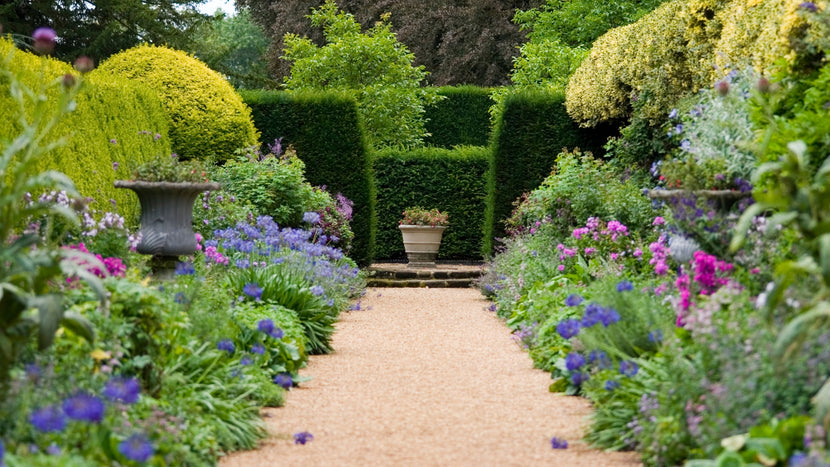
Using Color Theory to Design a Beautiful Landscape
Creating a visually stunning landscape involves more than just picking your favorite plants; it requires a thoughtful color selection and design approach. We often turn to color theory as a foundational tool for crafting gardens that not only captivate the eye but also evoke specific emotions and atmospheres.
By understanding and applying color theory, you can transform your landscape into a harmonious, vibrant space that enhances the overall aesthetic of your landscape.

Understanding the Basics of Color Theory
Color theory is the study of how colors interact and combine to create pleasing compositions. At its core are the color wheel, primary colors (red, blue, yellow), secondary colors (orange, green, purple), and tertiary colors, which are mixtures of primary and secondary hues. When designing a landscape, it's essential to consider color schemes that will create balance and interest.

Monochromatic Color Schemes
For a serene and cohesive look, consider a monochromatic color scheme. This involves using various shades, tints, and tones of a single color throughout your garden. For instance, a garden filled with different varieties of purple perennials, such as lavender, alliums, and salvias, can create a calming and unified aesthetic. The subtle variations in color provide depth and texture, making the garden visually interesting without overwhelming the senses.
Analogous Color Schemes
An analogous color scheme uses colors that are adjacent to each other on the color wheel, such as blue, green, and yellow. This approach creates a harmonious and naturally pleasing effect as the colors flow smoothly from one to the next. For example, combining blue salvias, green garden Junipers, and yellow echinaceas can create a cohesive and balanced garden with just enough variation to keep things interesting.

Complementary Color Schemes
If you want to make a bold statement in your garden, consider a complementary color scheme. This scheme pairs colors opposite each other on the color wheel, such as blue and orange or red and green. This contrast creates a dynamic and eye-catching effect that can make certain plants or garden areas pop. A classic example of this would be pairing red cardinal flowers with lush green boxwoods, creating a vibrant focal point in your garden.
Triadic Color Schemes
A triadic color scheme might be the perfect choice for those who love vibrant, multi-colored gardens. This scheme uses three colors evenly spaced around the color wheel: red, yellow, and blue. This combination is lively and balanced, allowing each color to stand out without competing with the others. In a Landscape, you could achieve this with Autumn Fire Azaleas, yellow rudbeckia, and blue salvias, resulting in an energetic and visually appealing garden.

Applying Color Theory to Plant Selection
Once you've chosen a color scheme, it's time to select the right plants to bring your vision to life. Consider not only the color of the flowers but also the foliage, as many plants have leaves that change color throughout the seasons, adding an additional layer of interest.
For instance, the silvery-blue foliage of lavender pairs beautifully with the deep purple blooms of Salvia nemorosa (Wood sage) in a monochromatic scheme. In an analogous scheme, the soft yellow of Achillea moonshine (Yarrow) can seamlessly transition into the lime green of Alchemilla mollis (Lady’s Mantle). For a complementary scheme, Gold Mop Cypress's bright yellow contrasts strikingly with Nepeta's cool blue (Catmint).
Creating Year-Round Interest

A well-designed landscape doesn't just shine during peak bloom times; it should offer visual interest throughout the year. When planning your garden, consider the bloom times of your chosen plants and aim for a succession of colors that change with the seasons. This ensures that your garden remains dynamic and appealing, even as different plants take turns in the spotlight.
Remember that fall and winter are important seasons in the landscape, and you can have fun creating visually appealing combinations with fall foliage as well. Use the same color theory, but think of foliage color rather than flowers.
Conclusion
Using color theory to design a landscape allows you to create a space that is not only beautiful but also emotionally resonant and visually balanced. By understanding how colors interact and applying this knowledge to your plant selections, you can craft a garden that is uniquely yours, filled with color and vibrancy that reflects your personal style.
Whether you opt for a soothing monochromatic palette, a harmonious analogous scheme, or a bold complementary pairing, the principles of color theory will guide you in creating a perennial garden that is as beautiful as it is thoughtfully designed.
